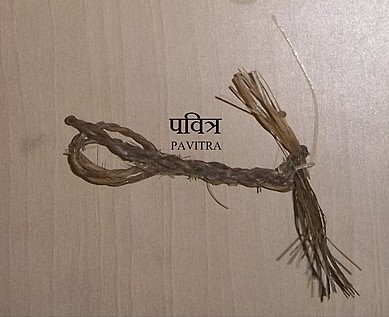|
Kusha Grass
The kusha () grass, the darbha () grass and the pavitram (), are the Sanskrit terms for ''Desmostachya bipinnata'' grass. This grass is of literary and ritual significance in Hinduism. In the performance of Vedic rituals such as the homam and tarpanam, the kusha grass is shaped like a ring and is worn by a priest on the ring finger of his right hand. Literature The Rigveda prescribes the sprinkling on the soma juice upon kusha grass in the performance of a rite. The Garuda Purana states that the kusha grass is born of the hair of Vishnu, and that it offers residence to the essence of all three of the Trimurti. It is among the many substances that is declared to be impossible to become impure despite frequent usage. The Bhagavata Purana features a legend from the Uttara Kanda in which Sita does not leave behind her son Lava in Valmiki's hermitage as she usually does while going out. The sage observes the boy's absence, and concludes that some animal had carried him away. Bel ... [...More Info...] [...Related Items...] OR: [Wikipedia] [Google] [Baidu] |
Trimurti
The Trimūrti (; Sanskrit: त्रिमूर्ति ', "three forms" or "trinity") are the trinity of supreme divinity in Hinduism, in which the cosmic functions of creation, maintenance, and destruction are personified as a triad of deities. Typically, the designations are that of Brahma the creator, Vishnu the preserver, and Shiva the destroyer. The Om symbol of Hinduism is considered to have an allusion to Trimurti, where the A, U, and M phonemes of the word are considered to indicate creation, preservation and destruction, adding up to represent Brahman. The Tridevi is the trinity of goddess consorts for the Trimurti. Evolution Brahma, Vishnu and Shiva seated on lotuses with their consorts, ca1770.jpg, Left: Brahma and Saraswati, Middle: Vishnu and Lakshmi, Right: Shiva and Parvati. Halebid3.JPG, An art depiction of the Trimurti at the Hoysaleswara temple in Halebidu Brahma Vishnu Mahesh.jpg, Trimurti, painting from Andhra Pradesh The Puranic period from the ... [...More Info...] [...Related Items...] OR: [Wikipedia] [Google] [Baidu] |
Plants In Hinduism
Plants are predominantly photosynthetic eukaryotes of the kingdom Plantae. Historically, the plant kingdom encompassed all living things that were not animals, and included algae and fungi; however, all current definitions of Plantae exclude the fungi and some algae, as well as the prokaryotes (the archaea and bacteria). By one definition, plants form the clade Viridiplantae (Latin name for "green plants") which is sister of the Glaucophyta, and consists of the green algae and Embryophyta (land plants). The latter includes the flowering plants, conifers and other gymnosperms, ferns and their allies, hornworts, liverworts, and mosses. Most plants are multicellular organisms. Green plants obtain most of their energy from sunlight via photosynthesis by primary chloroplasts that are derived from endosymbiosis with cyanobacteria. Their chloroplasts contain chlorophylls a and b, which gives them their green color. Some plants are parasitic or mycotrophic and have lost the ability ... [...More Info...] [...Related Items...] OR: [Wikipedia] [Google] [Baidu] |
Kshira Sagara
In Hindu cosmology, the Ocean of Milk (',', ''Malayalam: Pālāḻi'') is the fifth from the centre of the seven oceans. It surrounds the continent known as Krauncha. According to Hindu scriptures, the devas and asuras worked together for a millennium to churn the ocean and release amrita, the nectar of immortal life. It is spoken of in the ''Samudra Manthana'' chapter of the Puranas, a body of ancient Hindu legends. It is called as the ''Tiruparkadal'' (Sacred sea of milk) in Tamil, and is the place where Vishnu reclines over Adishesha, along with his consort, Lakshmi. Etymology "Ocean of Milk" is the English translation of the Sanskrit terms ', ' or ', from ' "milk" and ', ' "water, ocean" or ' "ocean." The term varies across Indic languages, including ''khir sagar'' in Bengali, ''pārkaḍal'' in Tamil, and ''Pāla Kadali'' in Telugu. The Churning of the Ocean One of the most fascinating episodes of Hindu mythology involves the churning of the cosmic ocean in order to obta ... [...More Info...] [...Related Items...] OR: [Wikipedia] [Google] [Baidu] |



